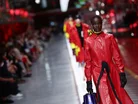McKinsey & Nike: The State of Fashion Manufacturing in 2025

The fashion industry will face a tumultuous period of shifting consumer behaviours, sluggish revenue growth and significant economic uncertainty in 2025, according to McKinsey.
'The State of Fashion 2025: Challenges At Every Turn' highlights the impact of inflation, climate change acceleration and global trade disruption on fashion manufacturing.
One area the report focuses on in particular is the relationship between economic trends and consumer preferences.
Rising costs of living have heightened consumer price sensitivity, changing spending priorities and fuelling the growing popularity of dupes- affordable equivalents of luxury or exclusive goods.
McKinsey predicts these factors are set to become even more pronounced in 2025, dramatically shaping the future of fashion.
The fight to attract consumer interest
Economic forecasts for the fashion industry, as highlighted in the report, indicate a continuation of low, single-digit revenue growth in 2025, following on from the slow pace set this year.
Luxury's dominance is being challenged as it was during the pandemic and 2010s, with non-luxury segments projected to lead increases in economic profit. As has been the case in recent years, this shift is being driven by affordability.
Geographic dynamics are also set to change significantly in 2025. Europe is set to benefit from reduced inflation and growing tourism, while the US is set to receive steady contributions from high-net-worth consumers.
Growth prospects in Asia, meanwhile, are being bolstered by emerging fashion markets in India, Japan and Korea, while China continues to struggle economically post-pandemic. China remains central to Asia's fashion market, but many brands are also diversifying focus to other countries.
For manufacturers wondering how to capture fashion consumer interest amid these shifts, McKinsey highlights the importance of broadening price offerings and localising go-to-market strategies.
Brand positioning needs to underscore value, aligning with the increase in off-price and resale segments.
Producing premium goods that are priced in such a range remains challenging, but it can be done through enhanced experiences and quality.
McKinsey's report highlights the return of in-store shopping, which has reached prepandemic levels in many areas.
But with the normalisation of online retail and dwindling status of the high street overall, keeping shoppers coming back will depend upon creating truly valuable shopping experiences with exceptional customer service and products.
This is especially important as many manufacturers shift attention from younger consumers to the "silver generation" – individuals over the age of 50 who represent a growing share of the fashion-buying market.
Engaging with this group requires tailored approaches and thoughtful products that address their unique priorities and spending power.
The report also notes how agile, emerging "challenger" brands are outperforming traditional industry incumbents, a reality which manufacturers across the industry must combat by adopting more flexible and innovative strategies.
The impact of the climate crisis and trade
The report details how trade shifts influenced by geopolitical developments will continue to impact sourcing and supply chain strategies.
Nearshoring and alignment with politically stable countries are becoming priorities as manufacturers seek greater resilience and efficiency.
These supply chains must be adaptable, emphasising inventory control to minimise overstock and shortages.
As governments continue to exert pressure on the fashion industry to reduce emissions and waste, more manufacturers must holistically adopt sustainable practices.
The climate crisis will continue to mould supply chains and consumer behaviour in 2025, with associated financial implications and new regulations necessitating that sustainability stays central to business strategies.
Manufacturers that embrace a long-term commitment to environmental responsibility – especially in the fashion industry – will unlock not only operational efficiencies but also a competitive edge.
Fashion leaders will need to navigate all these realities in order to thrive in 2025. Success will depend on a willingness to adapt and find new pathways for differentiation and growth – something manufacturers like Nike are doing through technology.
NIke's 2025 Ekiden collection
Nike has been harnessing Industry 4.0 technologies like additive manufacturing and AI to create trainers for athletes that are intimately tailored to their specific performance needs.
In 2025, the sports equipment manufacturer will unveil the Ekiden Collection, celebrating the unmatched passion and devotion of Japan’s long-distance relay runners.
Nike has worked with Japanese Ekiden runners since the 1990s, developing innovations to elevate their performance during gruelling relay competitions.
The Ekiden Collection campaign, 'Let Your Fire Run', features athletes from Chuo, Komazawa, Tokai and Toyo universities, who will compete in Japan’s premier Ekiden race, held in early January 2025.
The campaign references and highlights the challenging moments of an Ekiden training cycle, emphasising that true victory often requires pushing through uncomfortable moments.
The 2025 Ekiden Collection follows Nike's A.I.R collection revealed in Paris earlier this year, where the manufacturer had created 3D printed trainers in collaboration with some of the most elite athletes in the world.
"Getting to an athlete's truth requires authentic relationships," says Roger Chen, Nike VP, NXT, Digital Product Creation.
"At Nike, everything hinges on how well we know our athletes."
Here the manufacturer is providing distinctive value and differentiation- something which extends beyond collections like these to its products designed for everyday people.
In 2025 technology will be the means for many fashion manufacturers to differentiate themselves and provide the value that will make consumers hit purchase.
From transforming the sales experience to providing simulated try-on options, we're sure to see greater experimentation with technology from fashion manufacturers next year.
Make sure you check out the latest edition of Manufacturing Digital and also sign up to our global conference series - Manufacturing & Mobility LIVE
Manufacturing Digital is a BizClik brand
- Nike AIR: 3D Printing the Future of Athletic FootwearSmart Manufacturing
- New Year, New Manufacturing: Fashion in 2025Production & Operations
- Manufacturing Unwrapped: An Interview with Brooke WeddleProduction & Operations
- McKinsey: How Manufacturers can Ensure Future ProductivityProcurement & Supply Chain


